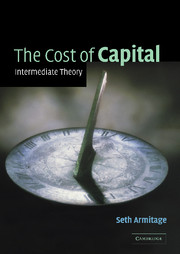Book contents
- Frontmatter
- Contents
- List of figures
- List of tables
- Preface
- Part I Expected Returns on Financial Assets
- 1 The cost of capital under certainty
- 2 Allowing for uncertainty: contingent states
- 3 The capital asset pricing model and multifactor models
- 4 The consumption-based model
- 5 The equity risk premium
- Part II A Project's Cost of Capital
- Part III Estimating the Cost of Capital
- References
- Index
4 - The consumption-based model
Published online by Cambridge University Press: 05 June 2012
- Frontmatter
- Contents
- List of figures
- List of tables
- Preface
- Part I Expected Returns on Financial Assets
- 1 The cost of capital under certainty
- 2 Allowing for uncertainty: contingent states
- 3 The capital asset pricing model and multifactor models
- 4 The consumption-based model
- 5 The equity risk premium
- Part II A Project's Cost of Capital
- Part III Estimating the Cost of Capital
- References
- Index
Summary
This chapter presents a model of asset valuation that emerges naturally in the contingent-states framework. The model, or class of models, answers the question: given the possible future pay-offs on an asset, how is the market price determined? This is the same as answering how the expected return on the asset is determined. As we have seen, the expected return on an asset of the same risk as a given project is the project's cost of capital. Thus, the consumption-based models of asset pricing are models of the cost of capital.
But, unlike the CAPM and some multifactor models, consumption-based models are not used to estimate the cost of capital in practice. Their interest for us lies in the fact that a consumption-based model offers a whole story regarding the expected return on an asset, given the possible pay-offs on the asset. In particular, it delivers predictions about the size of the risk-free rate and the size of the equity risk premium, whereas the risk-free rate and the equity premium are inputs, given exogenously, in the standard CAPM. Similarly, a multifactor model does not explain the risk-free rate nor the sizes of the premiums on the risk factors in the model. The CAPM and multifactor models answer the question: what is the relation between expected return and risk? This is only part of an answer to the question of how the expected return on an asset is determined.
- Type
- Chapter
- Information
- The Cost of CapitalIntermediate Theory, pp. 68 - 86Publisher: Cambridge University PressPrint publication year: 2005



